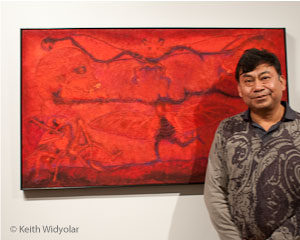The Beginning of Time ~ From the End of Time
by Keith Widyolar
Today, 12/12/12, is an auspicious day in the Gregorian calendar, and 12-21-12 is the end of the 5,000 year cycle of the ancient Mayan calendar. Just in time for the end of the world, the exhibition “Popul Vuh” of paintings and drawings by important Mexican artist Sergio Hernández opened last night at the Mexican Cultural Institute’s Galeria Octavio Paz with a presentation of the book “Sergio Hernandez,” by Edward J. Sullivan, professor of Art History at New York University.

Sergio Hernandez
Sergio Hernandez (Hernández) is part of the new generation of important contemporary Mexican artists coming out of Oaxaca, Mexico. “Popol Vuh” is the creation myth of the Quiché Mayan people of Guatemala’s western highlands. The Mayans are one of the great civilizations of the Americas based in today’s southern Mexico and Central America, especially Guatemala.
At their height around 900 AD, the Mayans were a group of more than 10 million people who built cities with as many as 50,000 inhabitants whose buildings and pyramids are still visited today. They developed mathematics that were several hundred years ahead of European. The Mayan calendar is considered to be more accurate than today’s Gregorian calendar.
If you grew up in the Spanish-speaking Americas, you probably learned about the “Popol Vuh” in grade school. If you grew up in the English-speaking Americas, you may well have never heard of it. The “Popul Vuh” is significant because it is one of the few remaining examples of the mythology of the pre-Hispanic Americas. The priests who accompanied the conquest of the Americas systematically stole or destroyed every religious object they could lay their hands on because it did not fit into their own religious views.
Yet, the “Popol Vuh” comes to us through the hand of Francisco Ximénez, a Dominican priest who transcribed the oral tradition sometime between 1701 and 1703 while posted in the Quiché lands. He wrote in two columns, one with the K’iche’ language and one in Castilian Spanish.
A quick comparison of the beginning of the bible with the beginning of the “Popol Vuh” reveals startling similarities in the two creation myths.
| “Genesis” | “Popol Vuh” |
| “In the beginning…” | “This is the beginning…” |
| “the earth was a formless wasteland, and darkness covered the abyss, while a mighty wind swept over the waters” | “There was nothing standing; only the calm water, the placid sea, alone and tranquil.” |
| “Then God said, ‘Let there be light,’ and there was light.” | “Then Tepeu and Gucumatz came together; then they conferred about life and light, what they would do so that there would be light and dawn” |
| “Then God said, “Let there be a dome in the middle of the waters, to separate one body of water from the other.” | “Let the water recede and make a void, let the earth appear and become solid…” |
It makes you wonder how two cosmologies separated by so much time and space could be so similar. The “Popul Vuh” is a landmark in establishing the realization that the mythological themes of humanity are universal, regardless of time or place.
